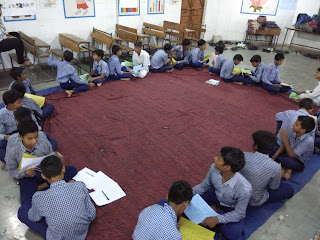“I don’t want to take
this sheet, can you give me another one” said one of the participant
“But why?”
To this question, not
one but 4-5 boys said in unison that pink is the color of girls, we are boys
and we shouldn’t take this!
We conducted our first
workshop on “Who am I?” with another set of 30 adolescent boys studying in
Government school, Dwarka sec-3, as part of gender, sexuality and reproductive
health program. The session began with sharing our work at Sahas and details of
weekly workshops on various thematic as part of program followed by the
importance of the curriculum for adolescents.
Following the
discussion on agreements, we did “Ek Ungli” energizer to bring the attention
and energy of the participants in workshop space! It was very interesting to
see many participants willing to do it again except one who refused to take
part stating that he didn’t enjoy dancing. While playing the game, I saw a boy
struggling with the steps – though I was instructing in a slow pace, he was
finding it hard to grab and do it, and at the same time I saw another boy
supporting him with the steps. I was taken aback, I always thought that this is
the easiest game and seeing a child struggling to do the same hit my consciousness
really hard.
In the first activity
the participants were invited to write answers to 15 questions based on “Myself”.
As against the previous class, these boys were very calm, they took time to
think and fill the answers.
In the second activity “Make
your identity map”, the adolescents were asked to write things, words or
sentences which they associate with themselves. After this, they had to share
their identity maps in the larger group, in this process they had to pair with
another person who shares one or more common points. This activity surprised us
in many ways; there was constant mention of dislike towards fighting, one of
them shared that he loved to learn new things, 2-3 boys said they love Hindi –
for me this was particularly surprising because most of the time people find it
shameful or they detest the language instead they take pride in saying that
they know or love English. One of the boys shared his entire life story in the
identity map- he had come from village to Delhi for studies, he shared his
ambitions, also about his friend helped him to score good marks. This is
actually the core of the activity that participants could figure out and relate
their life and identity. Few of the
participants added an extra circle to add more words to their identity map.
“I feel pity when I see
poor people, so when I grow up I would support such people”
Here the participants
didn’t just write hobbies as dancing but also choreography, just implying how
clear they are- they not only want to learn but have the desire to facilitate
that learning as well. I also noticed that none of them mentioned gender as
their identity but most of them paired according to their ambitions or hobbies.
On asking how they felt
being paired or not being able to find a person for pairing-
“I was surprised that
he has written the same thing though he sat exactly opposite to me!”
“I was upset that I didn’t
get a partner, I wanted to have a friend just like others”
“I was happy that
someone has written what I wrote”
What happened in the
next activity “Changing identities in the life cycle” was shocking – it’s something
that we never encountered in the past two years. The first picture was of a
child- instead of saying that the participants argued that this is a baby girl
because she looked like a girl, and then there was picture of a girl who was
engineer- the participants kept on insisting that either she is a laborer or nurse
or just girl! And for the third picture- instead of saying mother and child-
they ended up saying mother and son.
The issue of gender and
socio-economic identity to an extent dominated the workshop pointing clearly
the need for gender education in the schools. This was followed by sharing of
the stories of Mahatma Gandhi and Rani Laxmi Bai when they were adolescents.
The main objective being that during this stage, we have curiosities, we want
to do things our way, we may commit mistakes, however it is important to
understand and learn values because they lay the foundation for our life ahead
and never be scared to ask questions!
In the next activity “Catch
the ball and tell me”- participants shared their unique quality with the
action- someone said dancing and he showed Michael Jackson’s moon walk, another
one did a yoga pose, someone said he is good at skating, someone said cooking
and so on.
In the last activity “Will
you be my friend?” the participants were invited to get paired up with the
person they were least acquainted with- then share answers on 6 questions, and
finally present their new friend to the big circle. I was surprised and really
happy to see one of the boys moving towards the other boy (who had difficulty
in writing and reading) and making him his friend. Also both of them presented
each other in the larger circle followed by loud clapping. Not only this, I could
actually see how few of the students helped him in various places, motivating
and waiting for him to participate- my heart was filled with joy!
So, at the end the boy
who appeared to be vulnerable, scared and looked puzzled was smiling looking at
us, was playful and at that moment I thought that we have actually taken a step
ahead towards co-creating an inclusive classroom














No comments:
Post a Comment